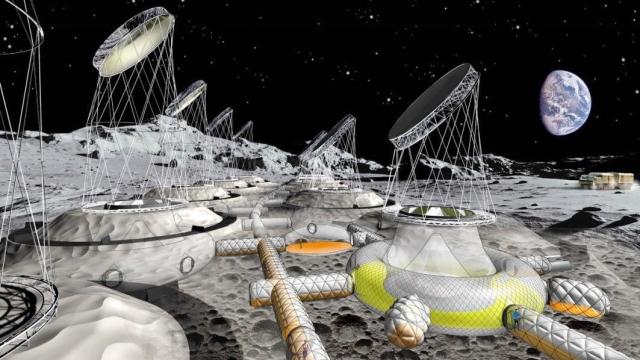Humans are going back to the Moon and this time they’re seeking to stay. NASA’s Artemis program promotes a sustainable vision of people living on and around the lunar surface, prompting some truly innovative ideas about how we might make that happen.
A group of researchers envisions inflatable greenhouse structures that are connected to one another to form a “village,” with large mirrors mounted on top to provide sunlight. Pneumocell, an Austrian company that designs inflatable structures inspired by biological cells, recently submitted the idea to the European Space Agency’s Open Space Innovation Platform.
The project, cleverly titled PneumoPlanet, includes a design for a lunar habitat on two regions located on the Moon’s south and north poles. “These sites offer optimal illumination conditions and are in the close vicinity of PSR’s (Permanently Shadowed Regions), which have a high probability to contain near surface water ice,” the team of researchers behind the project wrote. The structures would act as both greenhouses and living areas.
A key requirement of building a lunar habitat is that the material has to be lightweight since it will be transported from Earth to the Moon. It also needs to be easily assembled once these materials reach the lunar surface and the structure must have a tight airlock.
The PneumoPlanet would be transported as a prefabricated structure to the Moon and later inflated once it makes it there. When they’re fully inflated, the structures would need to be covered by around 16 feet (5 meters) of lunar regolith as a form of thermal isolation between the cold temperatures on the Moon and the inside of the module, as well as to protect it from cosmic radiation. Thankfully, there’s no shortage of dust on the Moon.
The structures themselves would measure around 21.95 m (22 meters) wide and are designed to connect to each other through a tunnel system, where more greenhouses can be attached as the habitat grows. The researchers envision a lunar village with about 16 modules. On top of each module would be a tower that holds a lightweight mirror made of silver coated foil to illuminate the greenhouse. Rotating mirrors would follow the Sun through the sky, directing sunlight to an artificial crater that reflects the light through another cone-shaped mirror, spreading it through the greenhouse.
The idea is for future lunar inhabitants to grow their own food within these structures. “The habitat should operate self-sufficiently in the long term by producing and recycling its own oxygen and food inside large greenhouses and almost exclusively by using solar irradiation power,” the researchers wrote.
In order to test it out, the team wants to build a prototype on Earth and see how well it performs before taking a bunch of inflatable houses on a trip to the lunar surface. Our future on the Moon looks bright — and inflatable.
